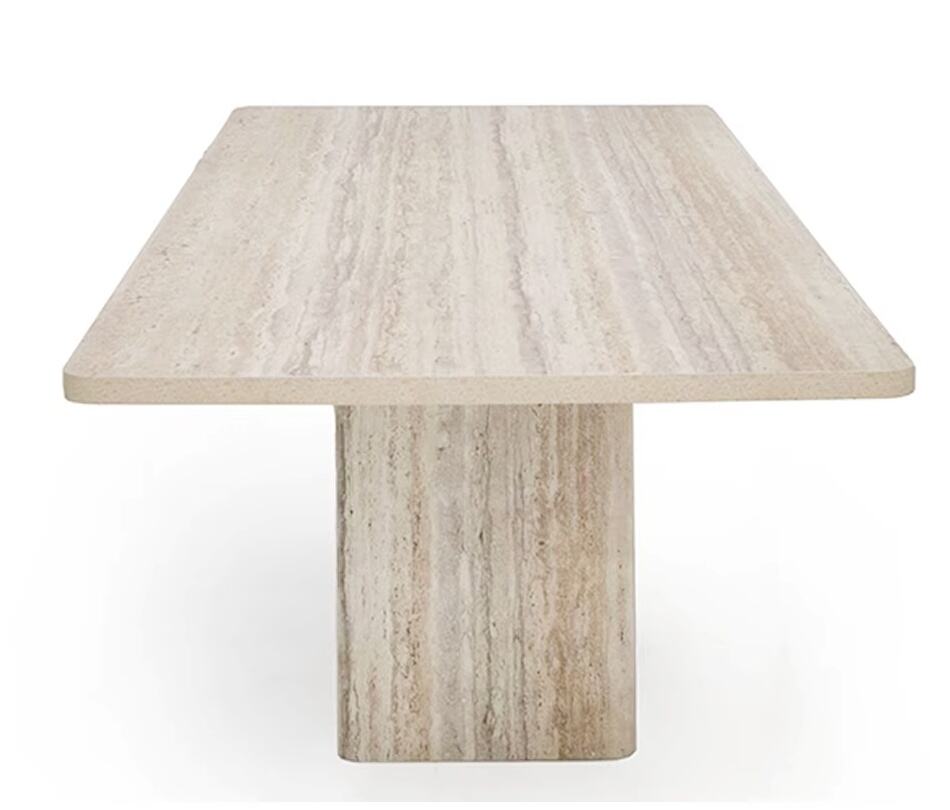Travertine Material Characteristics and Geological Origins
Understanding the formation process of travertine stone
Travertine comes into being when calcium carbonate precipitates quickly from groundwater that's rich in minerals, typically around geothermal springs and inside limestone caves. The process gets interesting when the water reaches the surface and pressure decreases. Just like what happens when someone opens a soda bottle, carbon dioxide escapes, which makes the calcium carbonate harden into those distinctive layered deposits we see today. According to studies done back in 2005 by Pentecost, all sorts of gas bubbles and bits of organic matter get caught up in this whole thing too. These trapped elements form the characteristic holes in the stone, kind of like nature's own record keeping system for old geothermal events.
Porous and pitted texture: Why travertine has natural voids
Travertine tends to have quite a bit more porosity compared to marble, sometimes around 10-15% more actually. This happens because when the stone forms, it traps all sorts of gases and bits of organic material inside. Those little holes we see aren't really defects at all. Instead they serve as kind of a geological diary telling us about where and how the stone came into being. Some manufacturers choose to keep these natural textures intact on their travertine tables since many customers appreciate the authentic look. But there are plenty of options where artisans fill those pores with epoxy resin too. The result is a much smoother surface that stands up better to everyday wear and tear without losing any of the stone's character.
Durability and hardness of travertine: How it compares to other stones
Travertine ranks 3–4 on the Mohs hardness scale:
| Stone | Mohs Hardness | Scratch Resistance |
|---|---|---|
| Travertine | 3–4 | Moderate |
| Marble | 3–5 | Moderate |
| Granite | 6–7 | High |
This mid-range durability makes it less brittle than onyx but more susceptible to scratching than quartzite. With thermal stability from –20°F to 120°F (–29°C to 49°C), travertine performs well in both indoor and outdoor table applications.
Density and structural integrity in travertine table construction
Travertine might be porous, but it packs quite a punch when it comes to density at around 2.5 to 2.7 grams per cubic centimeter, similar to what we see in concrete. This gives the stone good load bearing properties overall. When properly sealed and filled, travertine countertops can handle compression forces between 250 and 300 pounds per square inch, which makes them totally workable for regular home use. The way this stone forms in layers actually helps strengthen it across sections, so there's much less chance of cracks forming along those natural bedding lines during normal usage conditions.
Aesthetic Qualities of Travertine: Color, Tone, and Visual Warmth
Color Variations in Travertine: Cream, Beige, Gold, and Brown Tones
Travertine comes in all sorts of earthy colors, going from those gentle cream shades right up to rich brown tones depending on what minerals were around when it formed. When there's iron oxide present, we get those warm golden and rusty red colors, whereas calcite tends to give us paler beiges and ivories. The latest Stone Design Report from 2023 shows something interesting too - nearly 8 out of 10 interior designers are really into travertine these days because of its neutral color range. This makes sense since it just blends so well with almost any decorating style or color scheme someone might want to create.
Warm Color Palette and Its Impact on Interior Ambiance
The inherent warmth of travertine enhances spatial comfort, reflecting natural light to brighten interiors. Lighter tones open up smaller rooms, while richer browns add depth and sophistication. This versatility makes travertine a top choice among homeowners in temperate climates seeking inviting, year-round living spaces.
Natural and Rustic Appearance Enhancing Organic Design Themes
The rough texture and natural flaws in travertine make it perfect for those who love biophilic designs or rustic aesthetics. The stone's unique veins and rough feel stand out against man-made stones that look too perfect everywhere. When placed next to things like reclaimed wood, burlap curtains, or clay pots, travertine adds character to any space. People are really into this whole "raw luxury" thing these days, where they actually want materials that show their age and history. Natural variations aren't seen as flaws anymore but rather signs of real craftsmanship that will last through generations.
Common Finishes and Textures for Travertine Table Surfaces
Honed Finish: Smooth Matte Surface Ideal for Dining Tables
A honed finish delivers a smooth, non-reflective matte surface achieved by grinding the stone to eliminate high points. This practical yet elegant option resists watermarks and minor scratches, making it ideal for dining tables subject to frequent use without sacrificing aesthetic appeal.
Polished Travertine: Reflective Shine and Modern Elegance
Polishing involves buffing the surface to a glossy sheen, enhancing the stone’s natural veining and tonal depth. The reflective quality adds luminosity to interiors, suiting formal settings where appearance takes precedence over heavy wear. However, polished finishes are more prone to visible etching and require careful maintenance.
Tumbled and Brushed Textures for Enhanced Rustic Character
Travertine that's been tumbled has those nice rounded edges and looks like it's seen a lot of wear over time, kind of like what happens after hundreds of years of nature doing its thing. For brushed finishes, they actually run wire bristles across the surface which brings out all those little holes and the natural grain pattern, giving it that extra bit of texture people love. These two styles really bring out that rustic feel we're all going for these days. They work great outside or in those country style spaces too. Pair them with some good quality wrought iron fixtures or maybe some old reclaimed wood and suddenly the whole space just comes together much better than most folks expect.
Choosing the Right Finish Based on Lifestyle and Decor
When selecting a finish, consider:
- Maintenance needs (polished requires more frequent sealing; tumbled hides wear better)
- Aesthetic goals (matte for understated elegance; glossy for dramatic effect)
- Usage context (outdoor/high-traffic areas benefit from textured finishes)
A 2024 surfaces survey found that 68% of designers recommend honed or tumbled finishes for family homes due to their durability and organic character.
Functional Benefits of Using Travertine as a Table Top
Thermal Resistance and Suitability for Indoor and Outdoor Use
Travertine exhibits excellent thermal stability, resisting cracking between –30°C and 50°C. Unlike synthetic materials, it does not absorb excessive heat in sunlight, maintaining a comfortable touch temperature. This makes it ideal for patios, poolside furniture, kitchens, and transitional indoor-outdoor spaces.
Weight and Stability Advantages of Travertine Furniture
A standard 6-foot travertine dining table weighs 300–400 lbs (340–450 kg), offering exceptional stability. Its substantial mass prevents movement in breezy outdoor conditions and anchors large rooms as a permanent design focal point.
Aesthetic Versatility in Interior Design Applications
The neutral colors of travertine work really well across different design styles like modern minimalism, Mediterranean looks, and those popular rustic farmhouse vibes. Many interior designers combine travertine surfaces with various base materials such as steel frames, wooden legs, or even concrete supports. This creates a nice balance between looking good and actually working well in real spaces without losing that natural stone warmth. According to recent industry data from the 2024 Material Trends Report, around 78 percent of design pros are choosing travertine specifically for open floor plans where it helps tie together all sorts of different materials in one cohesive space.
Long-Term Value and Timeless Appeal of Travertine Tables
Well-maintained travertine tables retain up to 95% of their value over two decades, outperforming many wood and composite alternatives. Their geological durability ensures long-term structural integrity, while classic styling avoids obsolescence. Recent surveys show 94% of luxury homeowners regard travertine as a “forever material” (Architectural Digest 2023).
Maintenance and Longevity of Travertine Tables
Proper care ensures travertine tables age gracefully, combining resilience with evolving character. With consistent upkeep aligned with its natural properties, travertine becomes a lasting centerpiece across generations.
Care and maintenance of travertine: Daily cleaning best practices
Clean spills promptly and dust regularly using a soft cloth or brush with a pH-neutral cleaner. Avoid acidic substances like vinegar or citrus, which can degrade the calcium carbonate matrix. Blot—don’t wipe—spills to prevent spreading liquids into pores.
Sealing requirements for travertine tabletops to prevent staining
Apply a penetrating sealer during fabrication to fill microscopic voids and resist stains. Reapply every 1–3 years depending on usage: dining tables near kitchens typically need sealing every two years, while low-traffic pieces may go three years between treatments.
Dealing with spills, acids, and abrasive cleaners on travertine
For fresh spills, use the Press-Lift method with a dry cloth to absorb liquids within five minutes. If acid exposure causes etching (e.g., from lemon juice or tomatoes):
- Neutralize with a baking soda paste
- Re-seal the area
- Consult a professional if damage exceeds 1mm depth
Avoid abrasive scrubbers or alkaline cleaners that can dull the surface.
Resealing frequency and long-term protection methods
Test annually by placing a water droplet on the surface—if absorbed in under 10 minutes, resealing is needed. In arid climates, extend intervals by 6–12 months. Supplement sealing with felt pads under objects, thermal trivets for hot dishes, and annual professional inspections to maintain integrity.
Patina development: Embracing natural aging as a design feature
Over time, travertine develops a soft patina marked by warmer undertones, enhanced veining, and gently worn edges. This evolution reflects gentle use and adds character valued in organic interiors. Rather than masking wear, many homeowners celebrate it as a testament to lived-in beauty and enduring quality.
FAQ
What is travertine stone and how is it formed?
Travertine is a type of limestone formed when calcium carbonate precipitates from mineral-rich groundwater, often around geothermal springs or limestone caves.
Why is travertine stone pitted and porous?
Travertine's porous nature is due to gases and organic materials being trapped during its formation, creating natural voids that are often retained for their aesthetic appeal.
How does the hardness of travertine compare to other stones?
Travertine ranks 3-4 on the Mohs hardness scale, which is moderate compared to granite (6-7) and similar to marble (3-5).
What are common finishes available for travertine surfaces?
Travertine surfaces can have honed (matte), polished (shiny), tumbled, or brushed finishes, each providing different aesthetic and practical benefits.
What measures are needed for maintaining a travertine table?
Regular cleaning with a pH-neutral cleaner, sealing every 1-3 years, and avoiding acidic or abrasive substances help maintain travertine tables.
Table of Contents
- Travertine Material Characteristics and Geological Origins
- Aesthetic Qualities of Travertine: Color, Tone, and Visual Warmth
- Common Finishes and Textures for Travertine Table Surfaces
- Functional Benefits of Using Travertine as a Table Top
-
Maintenance and Longevity of Travertine Tables
- Care and maintenance of travertine: Daily cleaning best practices
- Sealing requirements for travertine tabletops to prevent staining
- Dealing with spills, acids, and abrasive cleaners on travertine
- Resealing frequency and long-term protection methods
- Patina development: Embracing natural aging as a design feature
- FAQ

